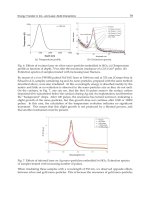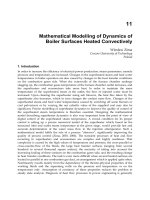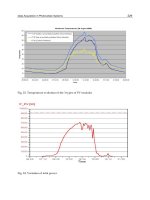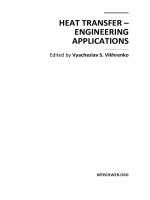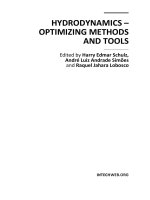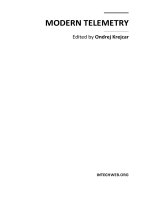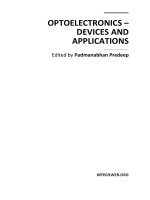Ferroelectrics Applications Part 1 potx
Bạn đang xem bản rút gọn của tài liệu. Xem và tải ngay bản đầy đủ của tài liệu tại đây (1.03 MB, 23 trang )
FERROELECTRICS‐
APPLICATIONS
Editedby
MickaëlLallart
Ferroelectrics - Applications
Edited by Mickaël Lallart
Published by InTech
Janeza Trdine 9, 51000 Rijeka, Croatia
Copyright © 2011 InTech
All chapters are Open Access articles distributed under the Creative Commons
Non Commercial Share Alike Attribution 3.0 license, which permits to copy,
distribute, transmit, and adapt the work in any medium, so long as the original
work is properly cited. After this work has been published by InTech, authors
have the right to republish it, in whole or part, in any publication of which they
are the author, and to make other personal use of the work. Any republication,
referencing or personal use of the work must explicitly identify the original source.
Statements and opinions expressed in the chapters are these of the individual contributors
and not necessarily those of the editors or publisher. No responsibility is accepted
for the accuracy of information contained in the published articles. The publisher
assumes no responsibility for any damage or injury to persons or property arising out
of the use of any materials, instructions, methods or ideas contained in the book.
Publishing Process Manager Silvia Vlase
Technical Editor Teodora Smiljanic
Cover Designer Jan Hyrat
Image Copyright Noel Powell, Schaumburg, 2010. Used under license from
Shutterstock.com
First published June, 2011
Printed in Croatia
A free online edition of this book is available at www.intechopen.com
Additional hard copies can be obtained from
Ferroelectrics - Applications, Edited by Mickaël Lallart
p. cm.
ISBN 978-953-307-456-6
free online editions of InTech
Books and Journals can be found at
www.intechopen.com
Contents
Preface IX
Part 1 Sensors and Actuators 1
Chapter 1 Giant k
31
Relaxor Single-Crystal Plate
and Their Applications 3
Toshio Ogawa
Chapter 2 MEMS Based on Thin Ferroelectric Layers 35
Igor L. Baginsky and Edward G. Kostsov
Chapter 3 Periodically Poled Acoustic Wave-Guide
and Transducers for Radio-Frequency
Applications 59
Sylvain Ballandras, Emilie Courjon, Florent Bassignot,
Gwenn Ulliac, Jérôme Hauden, Julien Garcia,
Thierry Laroche and William Daniau
Chapter 4 Ferroelectric Polymer for Bio-Sonar Replica 75
Antonino S. Fiorillo and Salvatore A. Pullano
Chapter 5 Ferroelectric Materials for Small-Scale Energy
Harvesting Devices and Green Energy Products 95
Mickaël Lallart and Daniel Guyomar
Part 2 Memories 115
Chapter 6 Future Memory Technology and Ferroelectric Memory
as an Ultimate Memory Solution 117
Kinam Kim and Dong Jin Jung
Chapter 7 Ultrahigh Density Probe-based Storage
Using Ferroelectric Thin Films 157
Noureddine Tayebi and Yuegang Zhang
VI Contents
Chapter 8 Fabrication and Study on One-Transistor-Capacitor
Structure of Nonvolatile Random Access Memory
TFT Devices Using Ferroelectric Gated Oxide Film 179
Chien-Min Cheng, Kai-Huang Chen, Chun-Cheng Lin,
Ying-Chung Chen, Chih-Sheng Chen and Ping-Kuan Chang
Chapter 9 Ferroelectric Copolymer-Based Plastic
Memory Transistos 195
Sung-Min Yoon, Shinhyuk Yang, Soon-Won Jung,
Sang-Hee Ko Park, Chun-Won Byun, Min-Ki Ryu, Himchan Oh,
Chi-Sun Hwang, Kyoung-Ik Cho and Byoung-Gon Yu
Chapter 10 Use of FRAM Memories in Spacecrafts 213
Claudio Sansoè and Maurizio Tranchero
Chapter 11 Adaptive Boolean Logic Using Ferroelectrics Capacitors
as Basic Units of Artificial Neurons 231
Alan P. O. da Silva, Cicília R. M. Leite, Ana M. G. Guerreiro,
Carlos A. Paz de Araujo and Larry McMillan
Preface
Ferroelectricityhasbeen one ofthe most used and studiedphenomenain both scien‐
tificandindustrialcommunities.Propertiesofferroelectricsmaterialsmakethempar‐
ticularlysuitableforawiderangeofapplications,rangingfromsensorsandactuators
to optical or memory devices. Since the discovery of ferroelectricity in Rochelle Salt
(whichus
edtobeusedsince1665)in1921byJ.Valasek,numerousapplicationsusing
suchaneffecthavebeendeveloped.Firstemployedinlargemajorityinsonarsinthe
middleofthe20
th
century,ferroelectricmaterialshavebeenabletobeadaptedtomore
andmoresystemsinourdailylife(ultrasoundorthermalimaging,accelerometers,gy‐
roscopes,filters…),andpromisingbreakthroughapplicationsare still underdevelop‐
ment (non‐volatile memory, optical devices…), making ferroelectrics one of tomor‐
row’smostimportantmaterials.
Thepurposeofthiscol
lectionistopresentanup‐to‐dateviewofferroelectricityandits
applications,andisdividedintofourbooks:
Material Aspects, describing ways to select and process materials to make
themferroelectric.
PhysicalEffects,aimingatexplainingtheunderlyingmechanismsinferroelec ‐
tricmaterialsandeffect
sthatarisefromtheirparticularproperties.
Characterization and Modeling, giving an overview of how to quantify the
mechanisms of ferroelectric materials (both in microscopic and macroscopic
approaches)andtopredicttheirperformance.
Applications,showingbreakthroughuseofferroelectrics.
Authorsofeachchapterhavebeenselectedaccordingtotheirscientif
icworkandtheir
contributionstothecommunity,ensuringhigh‐qualitycontents.
The present volume focuses on the applications of ferroelectric materials, describing
innovativesystemsthatuseferroelectricity.Thecurrentuseofsuchdevicesassensors
and actuators, in the field of acoustics, MEMS, micromotors and energy harvesting
will be presented in chapters 1 to 5. The next sectionproposes a particular emphasis
X Preface
onthe application of ferroelectricmaterials astransistors and memory devices(chap‐
ters6to11),showingoneofthefuturebreakthroughusesofthesematerials.
Isincerelyhopeyouwillfindthisbookasenjoyabletoreadasitwastoedit,andthat
itwillhelpyourresearchand/ orgi
venewideasinthewidefieldofferroelectricmate‐
rials.
Finally,I wouldliketotaketheopportunityofwritingthisprefacetothankalltheau‐
thors for theirhigh qualitycontributions,as well as the InTechpublishing team (and
especiallythepublishingprocessmanagerMs.SilviaVlase)fortheiroutstandingsu
p‐
port.
June2011
Dr.MickaëlLallart
INSALyon,Villeurbanne,
France
Part 1
Sensors and Actuators
1
Giant k
31
Relaxor Single-Crystal Plate
and Their Applications
Toshio Ogawa
Department of Electrical and Electronic Engineering,
Shizuoka Institute of Science and Technology,
Japan
1. Introduction
Typical ferroelectric ceramics, lead zirconate titanate (PZT) ceramics are widely used for
devices of electrical-mechanical energy conversion devices such as sensors and actuators,
which correspond to the five senses and foot & hand of human being. Recently, these devices
spread out in the computer controlled fields, for example, robotics and mechatronics. The
research and development of ferroelectric ceramics, particularly PZT ceramics, have mainly
focused on the material compositions to realize new electronic devices utilizing their
piezoelectric properties. Many researchers in companies and institutes have carried out R & D
on such chemical compositions since the discovery of piezoelectricity in PZT ceramics by Jaffe
et al. in 1954. On the other hand, through the new research on DC poling field dependence of
ferroelectric properties in PZT ceramics, the poling field has become an effective tool for
evaluation and control of the domain structures, which fix the dielectric and ferroelectric
properties of PZT ceramics. Therefore, PZT ceramics with different domain structures can be
fabricated even though the ceramic compositions remain the same. These ceramics are called
poling field domain controlled ceramic. It is thought that the domain controlled ceramics will
lead to a breakthrough and the appearance of new ferroelectric properties. The study on the
clarification of relationships between [compositions] vs [poling fields] vs [dielectric and
piezoelectric properties] in hard and soft PZT ceramics was applied to other ferroelectric
materials of lead titanate ceramics, lead-free ceramics such as barium titanate, alkali bismuth
niobate, alkali bismuth titanate ceramics and relaxor single crystals of Pb[(Zn
1/3
Nb
2/3
)
0.91
Ti
0.09
]O
3
(PZNT91/09) and Pb[(Mg
1/3
Nb
2/3
)
0.74
Ti
0.26
]O
3
(PMNT74/26) compositions.
This chapter describes how can be achieved the new ferroelectric properties such as giant
transverse-mode electromecanical coupling factor of k
31
over 80% and piezoelectric strain
d
31
constant of -2000 pC/N in PZNT91/09 and PMNT74/26 single crystals realized a mono-
domain single crystal by accurately controlling the domain structures. In addition, high-
efficiency piezoelectric unimorph and bimorph are also discribed as the devices using giant
k
31
single crystals.
2. Giant electromechanical coupling factor of k
31
mode and piezoelectric d
31
constant in Pb[(Zn
1/3
Nb
2/3
)
0.91
Ti
0.09
]O
3
single-crystal plates
Ferroelectric single crystals made of compounds such as Pb[(Zn
1/3
Nb
2/3
)
0.91
Ti
0.09
]O
3
(PZNT91/09) have been attracting considerable attention, because of the large longitudinal-
Ferroelectrics - Applications
4
mode electromechanical coupling factor of k
33
over 92%. Since high-quality and large
crystals are necessary to develop devices such as transducers for medical use, we have
undertaken and succeeded in the fabrication of PZNT91/09 single crystals with large
dimensions. In addition, for further applications to sensors and actuators, a large k
31
(d
31
)
mode as well as a large k
33
(d
33
) mode are needed.
2.1 Single-crystal sample preparation
The single crystals evaluated were grown by a solution Bridgman method with a Pt crucible
supported at the bottom by a conical insulator stand. The crystals without Pt contamination
from the crucible have the dimensions of 50 mm (2 inches) diameter, 35 mm height, and 325
g weight. The as-grown single crystals were cut along [100] of the original cubic direction
confirmed by X-ray diffraction and from Laue photographs. The single-crystal samples with
dimensions of 4.0
W
(width)x13
L
(length)x0.36
T
(thickness) mm for k
31
, k
t
and d
31
and
4.2
W
x4.2
L
x12
T
mm for k
33
and d
33
were prepared to evaluate the dielectric and piezoelectric
properties. Gold electrodes for the following DC poling and electrical measurements were
fabricated by conventional sputtering. Poling was conducted at 40 ºC for 10 min by
applying 1.0 kV/mm to obtain resonators with various vibration modes.
2.1.1 What is “giant k
31
piezoelectricity”?
Figure 1 shows the frequency responses of the impedance in k
33
and k
31
modes in the cases
of various coupling factors. It is easy to explain the wide frequency band, which
corresponds to the difference between anti-resonant frequency (fa) and resonant frequency
(fr), in higher coupling factors. An early work on a PZNT91/09 single crystal poled
Fig. 1. Frequency and phase responses of (a) k
33
and (b) k
31
fundamental modes in the cases
of various coupling factors.
Giant k
31
Relaxor Single-Crystal Plate and Their Applications
5
along [001] of the original cubic direction found that the values of k
31
(d
31
) and k
33
(d
33
)
modes were 62% (-493 pC/N) and 92% (1570 pC/N), respectively. In a more recent work,
the k
31
(d
31
) mode of 53% (-1100 pC/N) and the k
33
(d
33
) mode of 94% (2300 pC/N) were
reported for Pb[(Zn
1/3
Nb
2/3
)
0.92
Ti
0.08
]O
3
(PZNT92/08) single crystals poled along [001].
There are significant differences in the k
31
and d
31
modes between our result and the
previous results, despite finding almost the same k
33
(95%) and d
33
(2500pC/N).
A large difference between k
31
=80.8% and -d
31
=1700 pC/N in this study and k
31
=53-62%
and -d
31
=493-1100 pC/N in the previous studies for the single crystals is considered to be
due to the following. It is well known that dielectric and piezoelectric properties are
strongly affected by the quality of the crystals. It was pointed out that a small portion of
opaque parts in the crystal wafer significantly reduces the electromechanical coupling factor
of the crystals. Since PZNT91/09 crystals evaluated in this study have very high
transparency with a minimum defect level thus far reported, due to better control of the
Bridgman crystal growth, the highest k
31
and d
31
can be obtained.
2.1.2 Where does “giant k
31
piezoelectricity” come from?
Figures 2(a) and 2(b) show the temperature dependences of k
31
, k
33
and elastic compliance
(s
11
E
). Higher k
31
and k
33
were obtained in the rhombohedral phase below 80 ºC. The values
of s
11
E
in the rhombohedral phase are larger than those in the tetragonal phase.
Furthermore, the frequency constant (fc=frxL, where L is length), which corresponds to
half the bulk wave velocity, of the k
31
mode (fc
31
=522 Hz·m) is relatively small in
comparison with that of lead zirconate titanate (PZT) ceramics (fc
31
=1676 Hz·m). We believe
that the high piezoelectricity in the PZNT91/09 single crystal is due to the mechanical
softness of the rhombohedral phase, not the existence of a MPB, for easy deformation by the
poling field. This concept may be supported by the result that high k
33
(>90%) independent
of the rhombohedral composition, such as PZNT91/09, PZNT92/08 or
Pb[(Zn
1/3
Nb
2/3
)
0.955
Ti
0.045
]O
3
(PZNT95.5/4.5), was obtained.
Fig. 2. Temperature dependences of (a) electromechanical coupling factors (k
31
and k
33
) and
(b) elastic compliance (s
E
11
) in PZNT91/09 single crystal.
Ferroelectrics - Applications
6
In conclusion of this part, frequency spectrum analysis of the responses to vibration modes
was carried out in detail utilizing large PZNT91/09 single crystals of high quality. Giant k
31
and d
31
, as well as k
33
and d
33
, were obtained by efficient and uniform DC poling, it means a
mono-domain structure in the single-crystal plate as described the next part. The crystals with
these giant k
31
and d
31
will be applied for use in sensors and actuators with high performance.
2.2 Origin of giant piezoelectricity in PZNT91/09 single-crystal plates
In order to clarify the origin of giant piezoelectricity in PZNT91/09 single-crystal plates, the
poling field dependence of dielectric and ferroelectric properties were investigated in single-
crystal samples with demension of 4.0
W
x13
L
x0.36
T
mm for k
31
, k
t
and d
31
and 4.2
W
x4.2
L
x12
T
mm for k
33
and d
33
. The poling field dependence was carried out as follows; the poling was
conducted at 40 ºC for 10 min while varying the poling field (E) from 0 to 2000 V/mm. After
each poling, the dielectric and piezoelectric properties were measured at room temperature
using an LCR meter, an impedance analyzer and a d
33
meter. Moreover, the domain structures
were observed under polarized light with crossed nicols by an optical microscope.
2.2.1 DC poling field dependence of dielectric constant, d
33
constant, k
31
, k
t
, k
33
and
their frequency constants of fc
31
and fc
t
Figure 3 shows the effect of DC poling field (E) on dielectric constant (ε
33
T
/ε
0
) and
piezoelectric d
31
and d
33
constants. There were three stages in ε
33
T
/ε
0
with increasing E. The
first stage was E<400 V/mm, the second stage was 400 V/mm≦E<1000 V/mm, and the
third stage was E≧1000 V/mm. These stages in terms of dielectric constant mean that there
are three thresholds of domain rotation and switching in the direction of the poling field.
From our previous study, E of 300 V/mm in the first stage corresponds to the coercive field
(Ec) and E of 180º domain clamping on PZNT91/09 single crystals. While d
33
has
approximately the same tendency as the dielectric constant for the poling field, d
31
decreased abruptly over 1500 V/mm in the third stage. The giant -d
31
of nearly 1700 pC/N
could be obtained at 1000 V/mm≦E<1500 V/mm. On the other hand, the highest d
33
of
nearly 2500 pC/N could be obtained at 1000 V/mm≦E≦2000 V/mm. It was thought that
the difference between d
31
and d
33
at 1500 V/mm≦E≦2000 V/mm was due to the
difference in the domain structure in the directions of the length and the thickness for the
sample plate (4.0
W
x13
L
x0.36
T
mm).
Fig. 3. Poling field dependence of dielectric constant, and piezoelectric d
31
and d
33
constants
(poling temperature: 40 ºC, time: 10 min).
Giant k
31
Relaxor Single-Crystal Plate and Their Applications
7
Figure 4 shows the effect of poling field (E) on the electromechanical coupling factors (k
31
, k
33
)
and frequency constant (fc
31
). The plots of the poling field vs k
33
and k
31
were almost the same
as the plots of the poling field vs d
33
and d
31
shown in Fig. 3. While the giant k
31
of over 80%
was obtained at 1000 V/mm≦E<1500 V/mm, the highest k
33
of over 90% was obtained at 1000
V/mm≦E≦2000 V/mm. Furthermore, the frequency constant of the k
31
mode (fc
31
) showed
the lowest value of nearly 500 Hz·m at 1000 V/mm≦E<1500 V/mm. Therefore, it was found
that the giant k
31
(d
31
) and the minimum fc
31
appeared simultaneously at the specific poling
fields of 1000 V/mm≦E<1500 V/mm. With increasing E from 1500 V/mm to 2000 V/mm, k
31
decreased and fc
31
increased abruptly without any change in k
33
. The behavior observed for
the poling field vs k
31
(d
31
) and fc
31
in the third region suggested that a mono-domain in the
length direction (the direction perpendicular to the poling field) was achieved at 1000
V/mm≦E<1500 V/mm, and further, the mono-domain changed into a number of domains
(multi-domains in the plate) in the length direction at 1500 V/mm≦E≦2000 V/mm.
Fig. 4. Poling field dependence of k
31
and k
33
, and frequency constant fc
31
(poling
temperature: 40ºC, time: 10 min).
Figure 5 shows the effect of poling field (E) on electromechanical coupling factor (k
t
) and
frequency constant (fc
t
). The k
t
mode and fc
t
correspond to the thickness vibration for the
sample plate (4.0
W
x13
L
x0.36
T
mm). While k
33
increased from 80% to 95% with increasing E
from 400 V/mm to 2000 V/mm in Fig. 4, k
t
and fc
t
were independent of the poling field in
the same range of E. We believe the difference in the poling field dependence between k
33
and k
t
is due to the effect of the domain structure on the vibrations of k
33
and k
t
modes in
the thickness direction for the sample plate.
Fig. 5. Poling field dependence of k
t
and frequency constant fc
t
(poling temperature: 40 ºC,
time: 10 min).
Ferroelectrics - Applications
8
2.2.2 Domain structures of single-crystal plates at various poling fields
After each poling at E, both the surfaces of the sample plate (4.0
W
x13
L
x0.36
T
mm) were
polished and the domain structure in the plate area (4.0
W
x13
L
mm) was observed under
polarized transmission light with crossed nicols. The frequency responses of the
impedance in k
31
mode were also measured at every poling field. Figures 6(a)~6(d) show
the domain structures and the frequency responses in k
31
mode. The as-grown crystal
mainly had black and brown stripes as shown in Fig. 6(a). We believe that the stripes
consist of 180° domains alongside their domain walls. By applying E of 350 V/mm for 10
min at 40 ºC, the brown area increased, the boundaries between black and brown stripes
became unclear and the single response of the k
31
(47%) mode was obtained [Fig. 6(b)]. A
mono-domain crystal without domain walls was confirmed to exist at E=1000 V/mm. In
addition, the giant k
31
of nearly 80% appeared in the mono-domain crystal with the
single response and with the minimum frequency constant of fc
31
mode [Fig. 6(c)]. The
Fig. 6. Poling field dependence of domain structures in sample plate area (4.0
W
x13
L
mm) and
frequency responses of impedance and phase on k
31
mode; (a) as-grown (before poling), (b)
E=350 V/mm, (c) E=1000 V/mm and (d) E=2000 V/mm; the thickness of the plate is 0.36
mm and the broken line in Fig. 6(d) indicates a domain boundary.
Giant k
31
Relaxor Single-Crystal Plate and Their Applications
9
frequency constant (fc
31
) corresponds to half the bulk wave velocity (v
31
), and further,
there is a relationship between the Young’s modulus (Y) of the crystal and fc
31
as follows:
1/2 1/2
31 31
v 2 x fc 2 x fr x L Y ,
ρ
−
== =・
where fr and ρ are the resonant frequency of k
31
mode and the bulk density of the crystal,
respectively. Therefore, it is said that the most softened (i.e., with the lowest v
31
or fc
31
)
PZN91/PT09 crystals poled by the specific poling conditions (1000 V/mm≦E<1500 V/mm
at 40 ºC for 10 min) are essential to achieve the giant k
31
and d
31
. With E greater than 1500
V/mm, since the mono-domain changed into the muluti-domains, the single response of the
k
31
mode was divided into two responses and the value of fr or fc
31
increased. As a
consequence, k
31
was reduced to 63% [Fig. 6(d)]. It was thought that the reason only a few
domains were formed was the generation of strain in the direction perpendicular to the
poling field - namely, not in the sample thickness of 0.36
T
mm but in the sample plate area of
4.0
W
x13
L
mm, in the crystal poled by the higher poling field. This is summarized
schematically in Fig. 7 for the relationships among the poling fields and the domain
structures. In addition, Table 1 shows the relationships among the Young’s modulus (Y), k
33
and k
31
for various materials. It is found that the Y (0.89x10
10
N/m
2
) in rhombohedral
PZNT91/09 with giant k
31
is one order of magnitude smaller than the Y (6~9x10
10
N/m
2
) of
PZT ceramics and, roughly speaking, one order of magnitude larger than the Y (0.05x10
10
N/m
2
) of rubber. Therefore, we believe that the giant k
31
of over 80% arises from the
remarkable softness of the domain controlled single crystal due to the poling field.
Fig. 7. Schematics of domain structures (↖↙↖↙↖) in PZNT91/09 single crystal under various
poling fields; the arrow of E shows the direction of the poling field.
Ferroelectrics - Applications
10
Table 1. Relationships among Young’s modulus (Y), k
33
and k
31
in various materials.
In conclusion of this part, the origin of PZNT91/09 single crystals with giant k
31
of over 80%
and -d
31
constant nearly 1700 pC/N were due to a mono-domain structure in the crystal
plates. Controlling the poling conditions, the crystal plate with multi-domains changed into
one having the mono-domain in the direction perpendicular to the poling field as well as in
the direction parallel to the poling field. Futhermore, this ferroelectric domain controlled
single crystal by a poling field possessed the lowest frequency constant of fc
31
.
3. Giant k
31
in Pb(Mg
1/3
Nb
2/3
)O
3
-PbTiO
3
single-crystal plates
Another relaxor single crystal of Pb(Mg
1/3
Nb
2/3
)O
3
-PbTiO
3
(PMNT) is investigated in detail
regarding the k
31
mode and the conditions for obtaining giant k
31
and d
31
constant are
clarified.
3.1 Crystal plane dependence of giant k
31
in Pb(Mg
1/3
Nb
2/3
)O
3
-PbTiO
3
single-crystal
plates
Recently, a giant k
31
over 86% and a piezoelectric d
31
constant of nearly -2100 pC/N were
found for a (100) Pb[(Zn
1/3
Nb
2/3
)
0.91
Ti
0.09
]O
3
(PZNT91/09) single crystal poled in the [001]
direction. In order to realize giant k
31
, it was the significant relationship between the crystal
plane and the poling direction. Moreover, it was clarified that the giant k
31
and d
31
constant
could be obtained with a poling temperature of 40 ºC in the rhombohedral phase and with
sufficient poling fields of 1000~1500 V/mm. The origin of the giant k
31
and d
31
constant was
found to be due to the mono-domain structure in the direction perpendicular to the poling
field as well as in the direction parallel to the poling field. In this part, we investigate the
relationships between the crystal planes and the poling direction in (1-x)Pb(Mg
1/3
Nb
2/3
)O
3
-
xPbTiO
3
[PMNT(1-x)/x] single-crystal plates to obtain giant k
31
.
3.1.1 Realization of giant k
31
in PMNT plates
Figure 8 shows the DC poling field (E) dependence of relative dielectric constant (ε
r
) and k
31
in (100) PMNT68/32 and (110) PMNT74/26 single-crystal plates. The ε
r
(■) in (100) PMNT
has a peak at E=300 V/mm and decreases with increasing E. There is aging in ε
r
(■) and k
31
(□) for (100) PMNT, after 16 and 64 h at room temperature. The same phenomena were
observed in (110) PZNT91/09 single-crystal plates poled in the [110] direction. On the other
hand, the ε
r
(●) and k
31
(○) in (110) PMNT increased abruptly at E=200 V/mm and reached
constant values without aging. It was found that a giant k
31
of over 86% was obtained at
E≧200 V/mm in (110) PMNT single-crystal plates at the poling temperature of 40 ºC.
Giant k
31
Relaxor Single-Crystal Plate and Their Applications
11
0
2000
4000
6000
8000
10000
0 500 1000 1500 2000
E (V/m m )
ε
r
(- )
0
20
40
60
80
100
k
31
(% )
16 h aging
64 h aging
(100):ε
r
(■)/ k
31
(□)
(110):ε
r
(●)/ k
31
(○)
0
2000
4000
6000
8000
10000
0 500 1000 1500 2000
E (V/m m )
ε
r
(- )
0
20
40
60
80
100
k
31
(% )
16 h aging
64 h aging
(100):ε
r
(■)/ k
31
(□)
(110):ε
r
(●)/ k
31
(○)
Fig. 8. DC poling field dependence of ε
r
and k
31
in (100) and (110) PMNT single-crystal
plates.
The effects of poling temperature on k
31
, d
31
constant and the frequency constant (half of the
bulk wave velocity) of the k
31
mode (fc
31
) in (110) PMNT74/26 single-crystal plates are
shown in Fig. 9. The temperatures of 40 ºC (○), 100 ºC (□) and 120 ºC (∆) correspond to the
pseudo-cubic phase, the phase boundary between pseudo-cubic and tetragonal phases, and
the tetragonal phase, respectively (Fig. 10). It is confirmed that giant k
31
and d
31
constant
were obtained to polarize (110) PMNT plates in pseudo-cubic phase (the poling temperature
of 40 ºC), while applying E≧200 V/mm. In addition, the giant k
31
and d
31
constant were
accompanied by the lowest fc
31
, nearly 700 Hz·m. These results were the same as those of
(100) PZNT91/09 single-crystal plates with giant k
31
.
Fig. 9. DC poling field dependence of k
31
, d
31
and fc
31
in (110) PMNT74/26 single-crystal
plates at poling temperatures of 40 ºC (○), 100 ºC (□) and 120 ºC (△).
0
10
20
30
40
50
60
70
80
90
100
0 200 400 600 800 1000
E (V / m m )
k
31
(%)
0
200
400
600
800
1000
1200
1400
0 200 400 600 800 1000
E (V / m m )
-d
31
(pC /N )
600
700
800
900
1000
0 200 400 600 800 1000
E (V/m m )
fc
31
(H z ・m)
